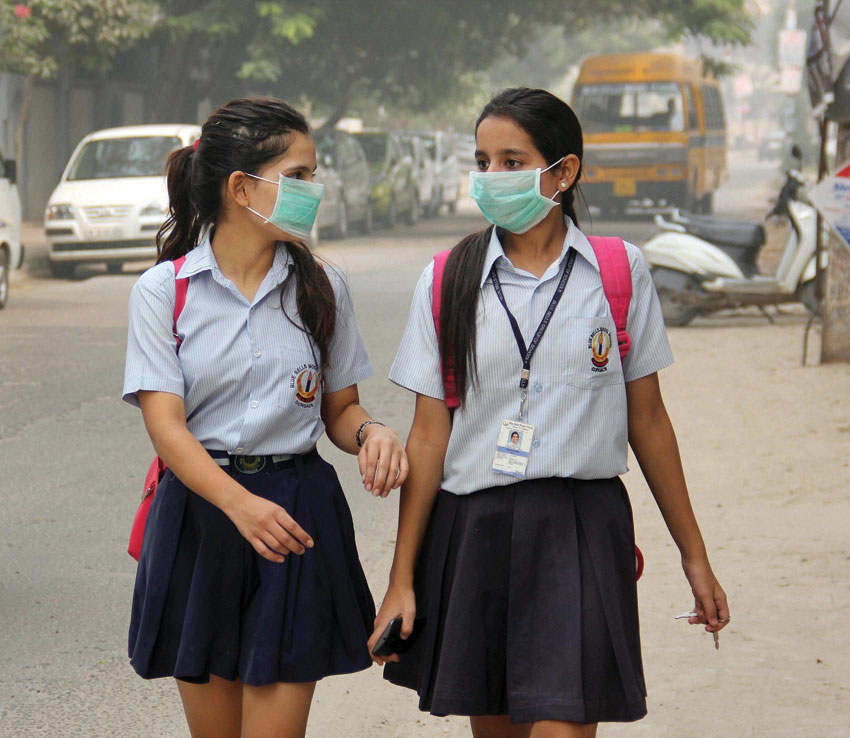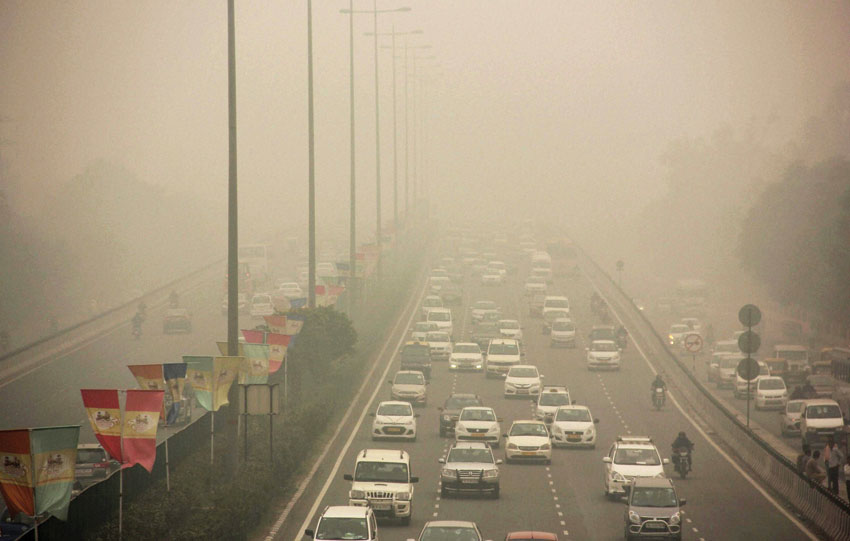India’s Real Apolitical Enemy: Worsening Levels of Air Pollution
Indian men play cricket amid heavy smog in New Delhi, Oct. 20. New Delhi was shrouded in a thick blanket of toxic smog. (Dominique Faget/AFP/Getty Images)
The herald of winters and pleasant temperatures has left India gasping for quality air. As per the air quality standards fixed by the World Health Organization, not even a single city in the country qualifies in the bracket of “healthy air.” Yet the nation is askance on how to grapple with this serious issue that has turned fatal in recent years, writes Priyanka Bhardwaj.
Cities such as Mumbai, Chennai, Bengaluru and Kolkata along the sea coasts have witnessed pollution spikes but their particulate matter are regularly flushed out unlike the ones that are situated in the Central and Northern regions, namely – Agra, Allahabad, Delhi and its National Capital Region.
Pollution has many components – carbon monoxide, sulphur dioxide, ammonia and particulate matter (PM) among others.
The frighteningly high levels of air PM have been attributed to a combination of a variety of factors, such as the drop in wind speeds and rise in moisture content of the retreating monsoon that prevent dust and PM from being quickly flushed out, burning of agriculture waste in the bread-basket state of Punjab and Haryana, dust due to construction and roads, toxic industrial effluents, and transportation emissions.
The direct and adverse fallout of this air pollution is the increasing numbers of air pollution-linked deaths and in 2015 alone the Lancet Commission on Pollution and Health authored by academics, policy experts and doctors from 24 organizations across the world, pegged premature deaths from 2.5 particulate matter (PM) air pollution at half a million.

In the global list of deaths due to air pollution, India ranks on the top and China comes second with 1.8 million deaths, and in India Delhi never fails to move down from its number one position as most polluted.
PM, made of dust, soot and smoke, is one of the most dangerous components that contaminate air and by PM2.5 it means particulate matters of less than 2.5 micron.

World Health Organization guidelines have fixed the maximum limit of PM 2.5 at 10 gram per meters cube (g/m3), but in Indian cities the annual average is at 59g/m3 and in Gwalior, Madhya Pradesh, it has touched 176g/m3.
The gravity of the issue is driven home by Lancet’s statement that, “Pollution is responsible for more deaths than a high-sodium diet (4·1 million), obesity (4·0 million), alcohol (2·3 million), road accidents (1·4 million), or child and maternal malnutrition (1·4 million). Pollution was also responsible for three times as many deaths as AIDS, tuberculosis, and malaria combined.”

The study shows categories air pollution as outdoor ambient air pollution, household air pollution and ambient ozone, all causes and contributors towards aggravation of heart disease, stroke, lung cancer and Chronic Obstructive Pulmonary Disorder (COPD).
Coupled with health disorders the resultant financial liability of the sufferers has been estimated to be an extra 1 to 1.5%.
Health and research specialists in Max Hospital in Gurugram, city on the verge of being declared “severe” in the air quality index, warn that spiking levels of pollution have been damaging the inner linings of veins and arteries, and increasing the presence of fragments of dead cells in the blood stream that lead to strokes.
Spokespersons of many medical centers in this city announce that though the susceptibility of elders and children is highest, the stroke burden of youngsters in the 35-40 age category has more than doubled in last five years and hospitals have been reporting admission of about 2-3 young heart patients every month.
On Oct. 29 during the observance of the World Stroke Day it was noted that worldwide about 15 million lives have been lost to strokes alone.
Out of this 6 million died and 5 million were rendered with permanent disabilities such as loss of sight and speech, paralysis and confusion due to air pollution.
As compared with the urban areas, in rural India lesser and slower pace of development may be responsible for comparatively cleaner outdoor air.

However, due to the burning of coal and wood for household fuel indoor air pollution levels have shot up by more than 20 times thereby increasing the chance of women suffering from COPD by 40%.
WHO studies point out 4.3 million deaths on account of household air pollution every year in India.
For the first time the University of Chicago’s Energy Policy Institute has spelled out an Air Quality-Life Index and according to this parameter if India met its own air quality standard for only PM 2.5 (40 µg/m³) every Indian would live an average 1 year more and the WHO standards an average Indian would live 4 years longer.
A Central government air quality monitoring agency called SAFAR, based out of Delhi, deduced in its latest report that emissions levels due to bursting of fireworks declined by around 40% during Diwali festival (Oct. 18-21) this year due to a specific regional ban on the sale of firecrackers by the Supreme Court.
Thankfully the air quality of Delhi did not deteriorate to such depths for the authorities to feel compelled to close down schools among other emergency measures as was the case last year. Delhi’s Air Quality Index, a day post Diwali, stood at 403, slightly better than in 2016 when it was 445.
However, in 2015 it was just at 360, so this achievement cannot be as relieving.
The Supreme Court-mandated Environment Pollution (Prevention and Control) Authority has thrown up many measures for enforcement as per the Graded Response Action Plan that comprises ban on diesel generator sets with certain exemptions.
But these are “too little and too late” measures and would perhaps not measure up to eliminating astonishingly high levels of pollution that itself in no good in any amount.
The challenge may well be the education and sensitization of Indians, especially the young who are the inheritors of Earth and environment but a strong and sustained result oriented mechanism that will ensure uniform and complete enforcement is the crying need of the hour.


